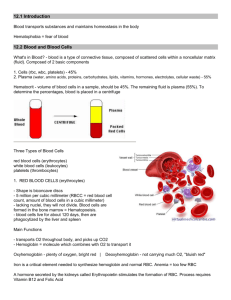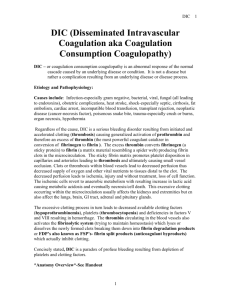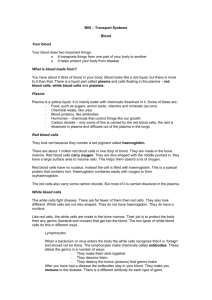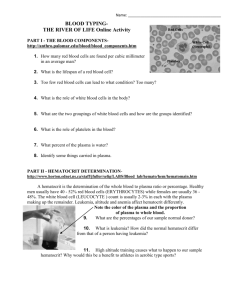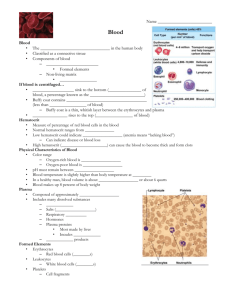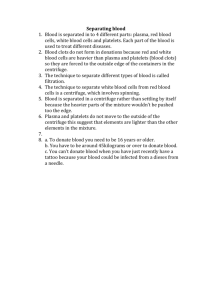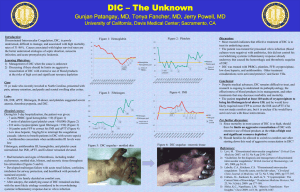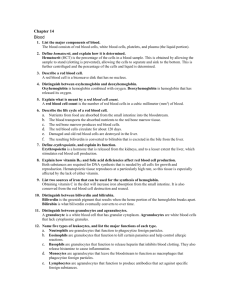Up2Date August 2012 Blood Products
advertisement
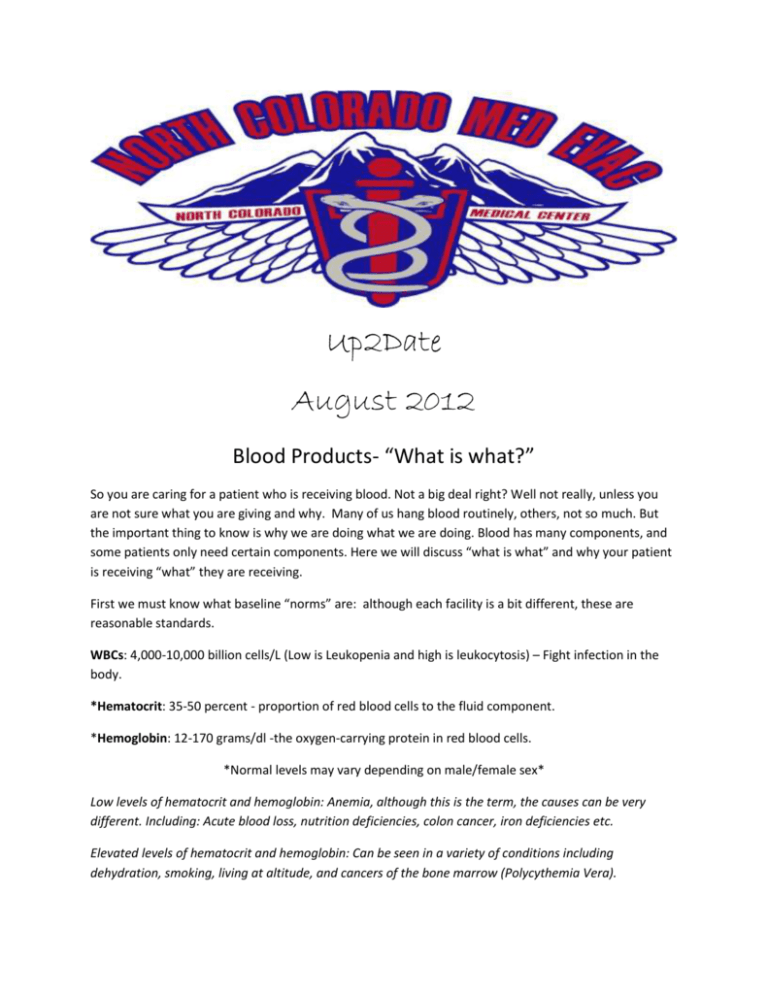
Up2Date August 2012 Blood Products- “What is what?” So you are caring for a patient who is receiving blood. Not a big deal right? Well not really, unless you are not sure what you are giving and why. Many of us hang blood routinely, others, not so much. But the important thing to know is why we are doing what we are doing. Blood has many components, and some patients only need certain components. Here we will discuss “what is what” and why your patient is receiving “what” they are receiving. First we must know what baseline “norms” are: although each facility is a bit different, these are reasonable standards. WBCs: 4,000-10,000 billion cells/L (Low is Leukopenia and high is leukocytosis) – Fight infection in the body. *Hematocrit: 35-50 percent - proportion of red blood cells to the fluid component. *Hemoglobin: 12-170 grams/dl -the oxygen-carrying protein in red blood cells. *Normal levels may vary depending on male/female sex* Low levels of hematocrit and hemoglobin: Anemia, although this is the term, the causes can be very different. Including: Acute blood loss, nutrition deficiencies, colon cancer, iron deficiencies etc. Elevated levels of hematocrit and hemoglobin: Can be seen in a variety of conditions including dehydration, smoking, living at altitude, and cancers of the bone marrow (Polycythemia Vera). Platelets: 150-400 billion/L- (Low is thrombocytopenia and high is thrombocytosis) Platelets are the component of the blood that is responsible for clotting. Fibrinogen: Fibrinogen = 200-400 mg/dL – (Low levels can be present in DIC or after large volume transfusions.) Fibrinogen is a protein produced by the liver, helps stop bleeding as it is one required proteins in the formation of a clot. It is not a product of the blood; however it is important to know what a normal level is and why it is important. While you are probably very familiar with the normal ranges, it is important to know why we give certain products: Whole Blood: Consists of red blood cells (RBC), plasma, and plasma proteins, restores intravascular volume and improves blood oxygen carrying capacity. Know that it may take a while to get the full benefit of the whole blood administration. Packed Red Blood Cells: This is one of the more common transfusions that we administer. If you are flying to transport a patient who is a multi-system trauma, GI bleed or if you have other concerns for acute blood loss, consider calling the facility before take-off and insure they have PRBC’s available for the transport. Packed RBC’s consist of Red Blood cells, a small amount of plasma, and an anticoagulant/preservative solution in a total volume of about 250 to 300 mL/unit. It helps restore blood volume while preventing fluid overload, improves blood oxygen carrying capacity, and reduces risk of metabolic complications. The average adult dose administered is 2 units; pediatric doses are generally calculated as 10 mL/kg. Usually administered when Hematocrit falls below 25, or when the patient is actively bleeding. Blood is a refrigerated product and must be kept cold until administration, so consider using a blood warming device such as a rapid infuser. Keeping your patient warm is paramount. Platelets: Improve the patients’ ability to clot. If the patient has a very low platelet count, platelets should be considered. Platelets are most often used in cancer patients, after extensive surgeries or clotting disorders. However, platelets should not be used in DIC (Disseminated intravascular coagulation) and HIT (Heparin Induced Thrombocytopenia). Plasma (Fresh or Fresh Frozen): Plasma is given to help control bleeding due to blood loss or blood clotting disorders related to liver disease and failure, disseminated intravascular coagulation (DIC), over anticoagulation with warfarin, all congenital or acquired clotting factor deficiencies, as well as dilutional coagulopathy resulting from massive blood replacement. The dosage depends on clinical situation and assessment of prothrombin time (PT), partial thromboplastin time (PTT). Plasma takes about 20-30 minutes to warm. Cryoprecipitate: Cryoprecipitate contains various clotting factors including fibrinogen, factor VIII, vonWillebrand and factor XIII. Indications include correction of deficiencies of factor VIII (i.e., hemophilia A and vonWillebrand’s disease), factor XIII, and/or in situations where a "fibrin glue” could be beneficial such as DIC. Decreased Fibrinogen levels may indicate that a patient is using fibrinogen faster than it can be produced, so the fibrinogen level will be low. The adult dosage is generally 10 units, which may be repeated every 8 to 12 hours until the deficiency is corrected or until hemostasis is achieved. Transfusion Reactions Types of Reactions Signs and Symptoms Hemolytic: Chills, fevers, back pain, headache, nausea, vomiting, chest pain, tachycardia, vascular collapse, hypotension and cyanosis. Allergic: Uriticaria, pruritus, chills, nausea, vomiting, wheezing, bronchospasm, dyspnea, circulatory collapse. Febrile: Fevers, chills, flushing, headache, confusions, nausea, vomiting. Circulatory overload: Cough, hemoptysis, rales, tachycardia, JVD, chest pain, dyspnea, increased O2 needs. References: Mayo Clinic Health – Retrieved from: http://www.mayoclinic.com/health/complete-bloodcount/MY00476/DSECTION=results. July 2012 Transfusion of Blood and Blood Products. Patricia Hartley 2011. Retrieved from: http://www.ceufast.com/courses/viewcourse.asp?id=183#Indications_for_Transfusion. July 2012


